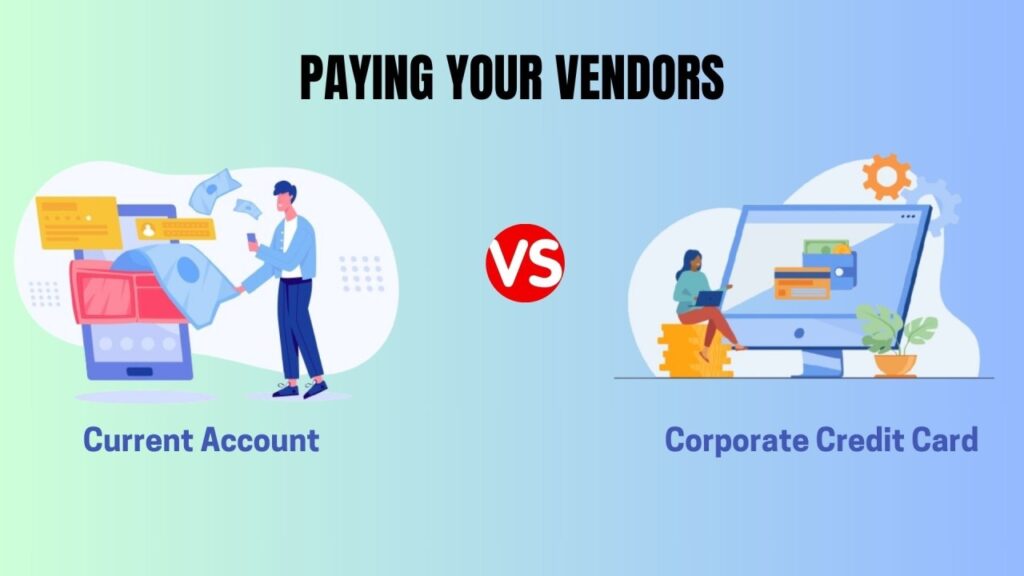The Smarter Approach to
Paying Vendors:
Optimizing Cash Flow in Business

In today’s effective vendor payments are crucial for smooth business operations. Choosing the right payment method can impact cash flow, financial flexibility, and overall business efficiency. Businesses, especially in logistics, often face the challenge of balancing immediate cash outflows with operational liquidity. The two most common payment approaches are utilizing the current account balance and corporate credit cards. Let’s explore these options to determine the best strategy for your business.
Paying Vendors from Current Account Balance
This method involves making direct payments from the business’s current account using NEFT, RTGS, IMPS, or bank cheques. It is a straightforward approach that requires maintaining adequate liquidity.
Key Features:
- Immediate debit from the account.
- No borrowing involved; payments are made using the company’s funds.
- Minimal charges, apart from standard bank transaction fees.
- Requires businesses to maintain a strong cash reserve.
Advantages:
- No interest or credit charges.
- Simple and straightforward accounting and reconciliation.
- No risk of overspending or credit misuse.
Disadvantages:
- Reduces available cash for other business expenses.
- Limits flexibility in case of low funds.
Paying Vendors Using Corporate Credit Cards
- Corporate credit cards provide an alternative to direct payments by offering a credit line that businesses can use for transactions, with repayment due within a grace period.
Key Features:
- Uses borrowed funds with a specific repayment timeline.
- Offers benefits like cashback, reward points, or travel perks.
- May incur interest charges if the balance is not paid on time.
Advantages:
- Helps improve cash flow management by delaying outflows.
- Risk of overspending or accumulating debt.
- Interest charges apply if payments are delayed.
- Not all vendors accept credit card payments, especially in cash Secured payments.
- Cashflow optimization.
- Bulk payments and automation.
- Dynamic discounting.
- Rewards for payment.
- Vendor relationship.
- Consolidates payments, simplifying tracking and reconciliation.
- Useful for online or international payments.
Disadvantages:
- Risk of overspending or accumulating debt.
- Interest charges apply if payments are delayed.
- Not all vendors accept credit card payments, especially in cash-dependent industries.
Real-World Application in the Logistics Industry
In the logistics industry, businesses frequently make multiple payments for fuel, tolls, supplier materials, warehouse rentals, and fleet maintenance. Here’s how each payment method applies:
Current Account Example:
A logistics company may need to pay:

Warehouse Vendor via NEFT

Fuel suppliers via RTGS.

Fleet maintenance vendors via IMPS.
Each payment is processed separately from the current account, requiring adequate liquidity to manage operational expenses.
Corporate Credit Card Example:
· A logistics company can use a corporate card for:

Fuel purchases across multiple locations.

Toll payments via FASTag recharge.

Third-party freight shipment bookings.
Using a corporate card consolidates payments, delays cash outflows, and earns cashback or fuel points, improving financial efficiency.
Choosing the Best Option
- Use the Current Account when your company has sufficient reserves and wants to avoid credit charges.
- Use a Corporate Credit Card when flexibility, payment consolidation, or improved cash flow management is needed, especially for frequent, smaller payments.
Conclusion
Selecting the right vendor payment method depends on your business’s cash flow, spending patterns, and financial strategy. While direct payments ensure financial discipline, corporate credit cards offer flexibility and potential rewards. A hybrid approach, using both methods strategically, can optimize cash flow and ensure operational efficiency. Evaluate your business needs carefully to make informed financial decisions that drive growth and stability.


